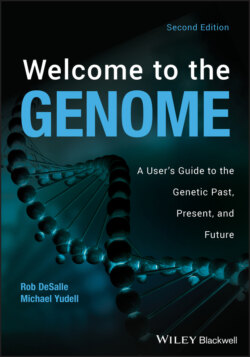Читать книгу Welcome to the Genome - Michael Yudell - Страница 10
FOREWARD: STILL, THE GENOMIC REVOLUTION
ОглавлениеIn 2001, the American Museum of Natural History (AMNH) produced a daring and innovative exhibition called the Genomic Revolution. It transcended the usual subject matter and issues that the AMNH addresses with its exhibitions. The show used cutting‐edge interactives and design and covered many up‐to‐date subjects in genomics. Development of the show was as dynamic as the field itself, with revisions to data on genome size and other scientific content required within days before the show opened. We were fortunate that the show also anticipated the announcement of the first draft of the human genome that same year. The production of the show was part of the AMNH’s desire to enter the twenty‐first century with a genomics bang as we also established an institute for comparative genomics and the Ambrose Monell frozen tissue facility at the museum – two very rare and still successful enterprises for a natural history museum.
The show was very popular despite the occurrence of the 9/11 attack and its aftermath during its run, drawing over half a million visitors. Since its run at the AMNH it was installed in natural history or science museums in Toronto, Canada, Sao Paulo, Brazil, Mexico City, Mexico, and several American cities. As a companion to the show, my colleagues Rob DeSalle and Michael Yudell produced a very popular volume entitled Welcome to the Genome that tells the story of genetics, genomics, and the sequencing of the human genome. These two authors were involved in the development of the exhibition, one as its curator and the other as a content advisor. Their treatment of the topic spanned discussion of Mendel, Darwin, development of molecular biology, and the DNA sequencing technology of the time, as well as delving into the ethical conundrums caused by the capacity to decipher the so‐called stuff of life – DNA. Rob, as a curator at the AMNH, has led the museum’s effort to broaden its scope of research and education and demonstrate our capacity to connect with dynamic fields like genomics and with applications like human health.
Now, nearly 20 years later, Rob and Michael have produced a second edition, demonstrating that many things have changed since their first version, and at the same time some remain the same. The sequencing technology has developed to the point where the $1000 human genome is possible and where we are now getting sequences of the microbes that live in and on the body called the microbiome. The tree of life, a major interest here at the AMNH that Rob and Mike delve into in great detail in this book, has also benefited from the development of genomic technology, which has improved our understanding of human evolution, both deep in the past and more recent. It is now possible to sequence the genomes of Neanderthals and long dead Homo sapiens specimens, giving science an unprecedented view of our past history. Ethical issues have also emerged as the technology gets faster and cheaper. Development of new gene editing technologies opens the way for germline editing of humans and raises many questions about the application of this technology. This new edition by Rob and Michael will provide the kind of modern, current, and thought‐provoking information that is in keeping with one of the most important scientific revolutions of our time.
As a natural history museum, the AMNH strives to educate the public about science in the natural world and to teach the public about how science is accomplished, who scientists are, and what the science might mean to their future. This edition of Welcome to the Genome is a wonderful extension of that initial effort in education that the AMNH launched nearly two decades ago.
Michael J. Novacek
Provost of Science
American Museum of Natural History
